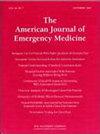Retrospective review of thrombolytic use for cardiac arrest due to suspected pulmonary embolism
IF 2.7
3区 医学
Q1 EMERGENCY MEDICINE
引用次数: 0
Abstract
Background
Massive pulmonary embolism (PE) causing obstructive shock can lead to circulatory failure and cardiac arrest. There is a paucity of data describing current practice around thrombolytic use and outcomes in this patient population.
Objective
The objective of this study was to describe the characteristics and outcomes of patients who received a thrombolytic agent during cardiac arrest due to suspected PE, including efficacy and safety.
Methods
This study was a retrospective, descriptive cohort of 32 adult patients who received alteplase or tenecteplase in the emergency department during active cardiac arrest. Agent selection and dosing were at the discretion of the primary provider.
Results
Most patients presented with a witnessed out-of-hospital cardiac arrest with a non-shockable rhythm. The mean age was 63 years. Dyspnea was most commonly reported prior to cardiac arrest. The median dose for alteplase was 50 mg and for tenecteplase was 45 mg. Eleven patients achieved ROSC after thrombolytic administration; seven of these patients survived to hospital admission. All but one patient experienced a major bleeding event during admission. Ultimately, only two patients survived to hospital discharge. A subgroup analysis compared patients administered alteplase to those administered tenecteplase. Nine of the eleven patients that achieved ROSC were administered alteplase, five of which survived to hospital admission. All five patients experienced a major bleeding event. Two of the eleven patients that achieved ROSC were administered tenecteplase, both of which survived to hospital admission. One patient experienced a major bleeding event. Ultimately, only one patient in each group survived to hospital discharge.
Conclusion
This study provides new data regarding the outcomes of thrombolytic therapy in patients experiencing cardiac arrest due to suspected massive PE. Despite administration of thrombolytics, survival to hospital admission and subsequent survival to hospital discharge were seen in only a very small proportion of patients. Further research is necessary to optimize the management of this life-threatening condition.
溶栓治疗疑似肺栓塞引起的心脏骤停的回顾性研究
背景:大面积肺栓塞(PE)引起的阻塞性休克可导致循环衰竭和心脏骤停。目前在这类患者群体中,有关溶栓治疗的实践和结果描述的数据缺乏。本研究的目的是描述因疑似PE引起的心脏骤停期间接受溶栓药物治疗的患者的特征和结果,包括疗效和安全性。方法:本研究是一项回顾性、描述性队列研究,纳入了32名在急诊科接受阿替普酶或替尼替普酶治疗的心脏骤停患者。药物的选择和剂量由主要提供者自行决定。结果大多数患者出现院外心脏骤停,心律非震荡。平均年龄为63岁。呼吸困难最常见于心脏骤停前。阿替普酶的中位剂量为50毫克,替奈普酶为45毫克。11例患者溶栓后达到ROSC;其中7名患者存活至住院。除一名患者外,所有患者在入院期间均出现大出血事件。最终,只有两名患者活到出院。亚组分析比较了服用阿替普酶和服用替尼替普酶的患者。11例达到ROSC的患者中有9例给予阿替普酶治疗,其中5例存活至住院。所有5例患者均出现大出血事件。11例达到ROSC的患者中有2例接受了替尼替普酶治疗,两例患者均存活至住院。一名患者出现大出血事件。最终,每组只有一名患者存活至出院。结论本研究为疑似大量肺动脉栓塞引起的心脏骤停患者的溶栓治疗结果提供了新的数据。尽管给予溶栓治疗,但只有非常小比例的患者存活至入院和随后存活至出院。需要进一步的研究来优化这种危及生命的疾病的管理。
本文章由计算机程序翻译,如有差异,请以英文原文为准。
求助全文
约1分钟内获得全文
求助全文
来源期刊
CiteScore
6.00
自引率
5.60%
发文量
730
审稿时长
42 days
期刊介绍:
A distinctive blend of practicality and scholarliness makes the American Journal of Emergency Medicine a key source for information on emergency medical care. Covering all activities concerned with emergency medicine, it is the journal to turn to for information to help increase the ability to understand, recognize and treat emergency conditions. Issues contain clinical articles, case reports, review articles, editorials, international notes, book reviews and more.

 求助内容:
求助内容: 应助结果提醒方式:
应助结果提醒方式:


